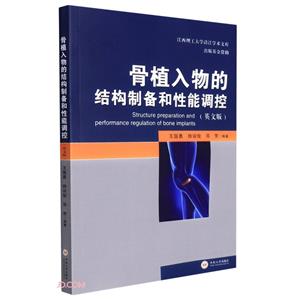中圖網(wǎng)小程序
一鍵登錄
更方便
本類五星書更多>
-
>
中醫(yī)入門必背歌訣
-
>
醫(yī)驗集要
-
>
尋回中醫(yī)失落的元神2:象之篇
-
>
補遺雷公炮制便覽 (一函2冊)
-
>
人體解剖學常用詞圖解(精裝)
-
>
神醫(yī)華佗(奇方妙治)
-
>
(精)河南古代醫(yī)家經(jīng)驗輯
骨植入物的結構制備和性能調控(英文版) 版權信息
- ISBN:9787548747048
- 條形碼:9787548747048 ; 978-7-5487-4704-8
- 裝幀:一般膠版紙
- 冊數(shù):暫無
- 重量:暫無
- 所屬分類:>>
骨植入物的結構制備和性能調控(英文版) 內容簡介
本書為英文版專著, 系統(tǒng)介紹現(xiàn)階段生物增材制造技術制備骨植入物的研究進展, 針對骨植入的臨床應用要求, 闡述了利用增材制造技術實現(xiàn)骨植入物復雜外形和內部多孔結構的一體化制備的研究進展 ; 同時, 針對骨植入物的力學性能、降解速率、抗菌性能和生物學性能優(yōu)化調控方法等四個方面詳細闡述研究進展, 以期對骨缺損組織的再生修復與功能重提供理論支撐和科學依據(jù)。
骨植入物的結構制備和性能調控(英文版) 目錄
Chapter 1 Regulation of mechanical properties
1.1 Crystallinity and reinforcement in Poly-l-lactic acid scaffold induced by
carbon nanotubes
1.1.1 Introduction
1.1.2 Materials and methods
1.1.3 Results and discussion
1.1.4 Conclusions
1.2 Cellulose nanocrystals as biobased nucleation agents in poly-l-lactide
scaffold: crystallization behavior and mechanical properties
1.2.1 Introduction
1.2.2 Materials and methods
1.2.3 Results and discussion
1.2.4 Conclusions
1.3 Surface modified graphene oxide with compatible interface enhances poly-l-lactic acid bone scaffold
1.3.1 Introduction
1.3.2 Materials and methods
1.3.3 Results and discussion
1.3.4 Conclusions
References
Chapter 2 Regulation of degradation properties
2.1 Biodegradation mechanisms of selective laser melted Mg-xA1-Zn alloy
grain size and intermetallie phase
2.1.1 Introduction
2.1.2 Experiment and method
2.1.3 Results and discussion
2.1.4 Conclusions
2.2 Laser additive manufacturing of Mg-based composite: formability
microstrueture and degradation behavior A
2.2.1 Introduction
2.2.2 Materials and methods
2.2.3 Results and discussion
2.2.4 Conclusions
2.3 Mesoporous carbon as galvanic-corrosion activator accelerates Fe
degradation
2.3.1 Introduction
2.3.2 Materials and methods
2.3.3 Results and discussion
2.3.4 Conclusions
References
Chapter 3 Regulation of antibacterial properties
3.1 A strawberry-like Ag-decorated barium titanate enhances piezoelectric and
antibacterial activities of polymer scaffold
3.1.1 Introduction
3.1.2 Materials and methods
3.1.3 Results and discussion
3.1.4 Conclusions
3.2 A peritectic phase refines the microstructure and enhances Zn implants
3.2.1 Introduction
3.2.2 Materials and methods
3.2.3 Results and discussions
3.2.4 Conclusions
References
Chapter 4 Regulation of biological properties
4.1 Construction of an electric microenvironment in piezoelectric scaffolds
fabricated by selective laser sintering
4.1.1 Introduction
4.1.2 Experiments
4.1.3 Results and discussion
4.1.4 Conclusions
4.2 Functionalized BaTiO3 enhances piezoelectric effect towards cell response
of bone scaffold
4.2.1 Introduction
4.2.2 Materials and methods
4.2.3 Results and discussion
4.2.4 Conclusions
4.3 Graphene oxide assists polyvinylidene fluoride scaffold to reconstruct
electrical microenvironment of bone tissue
4.3.1 Introduction
4.3.2 Experiments
4.3.3 Results and discussion
4.3.4 Conclusions
References
1.1 Crystallinity and reinforcement in Poly-l-lactic acid scaffold induced by
carbon nanotubes
1.1.1 Introduction
1.1.2 Materials and methods
1.1.3 Results and discussion
1.1.4 Conclusions
1.2 Cellulose nanocrystals as biobased nucleation agents in poly-l-lactide
scaffold: crystallization behavior and mechanical properties
1.2.1 Introduction
1.2.2 Materials and methods
1.2.3 Results and discussion
1.2.4 Conclusions
1.3 Surface modified graphene oxide with compatible interface enhances poly-l-lactic acid bone scaffold
1.3.1 Introduction
1.3.2 Materials and methods
1.3.3 Results and discussion
1.3.4 Conclusions
References
Chapter 2 Regulation of degradation properties
2.1 Biodegradation mechanisms of selective laser melted Mg-xA1-Zn alloy
grain size and intermetallie phase
2.1.1 Introduction
2.1.2 Experiment and method
2.1.3 Results and discussion
2.1.4 Conclusions
2.2 Laser additive manufacturing of Mg-based composite: formability
microstrueture and degradation behavior A
2.2.1 Introduction
2.2.2 Materials and methods
2.2.3 Results and discussion
2.2.4 Conclusions
2.3 Mesoporous carbon as galvanic-corrosion activator accelerates Fe
degradation
2.3.1 Introduction
2.3.2 Materials and methods
2.3.3 Results and discussion
2.3.4 Conclusions
References
Chapter 3 Regulation of antibacterial properties
3.1 A strawberry-like Ag-decorated barium titanate enhances piezoelectric and
antibacterial activities of polymer scaffold
3.1.1 Introduction
3.1.2 Materials and methods
3.1.3 Results and discussion
3.1.4 Conclusions
3.2 A peritectic phase refines the microstructure and enhances Zn implants
3.2.1 Introduction
3.2.2 Materials and methods
3.2.3 Results and discussions
3.2.4 Conclusions
References
Chapter 4 Regulation of biological properties
4.1 Construction of an electric microenvironment in piezoelectric scaffolds
fabricated by selective laser sintering
4.1.1 Introduction
4.1.2 Experiments
4.1.3 Results and discussion
4.1.4 Conclusions
4.2 Functionalized BaTiO3 enhances piezoelectric effect towards cell response
of bone scaffold
4.2.1 Introduction
4.2.2 Materials and methods
4.2.3 Results and discussion
4.2.4 Conclusions
4.3 Graphene oxide assists polyvinylidene fluoride scaffold to reconstruct
electrical microenvironment of bone tissue
4.3.1 Introduction
4.3.2 Experiments
4.3.3 Results and discussion
4.3.4 Conclusions
References
展開全部
書友推薦
- >
羅曼·羅蘭讀書隨筆-精裝
- >
隨園食單
- >
唐代進士錄
- >
龍榆生:詞曲概論/大家小書
- >
企鵝口袋書系列·偉大的思想20:論自然選擇(英漢雙語)
- >
有舍有得是人生
- >
姑媽的寶刀
- >
人文閱讀與收藏·良友文學叢書:一天的工作
本類暢銷















